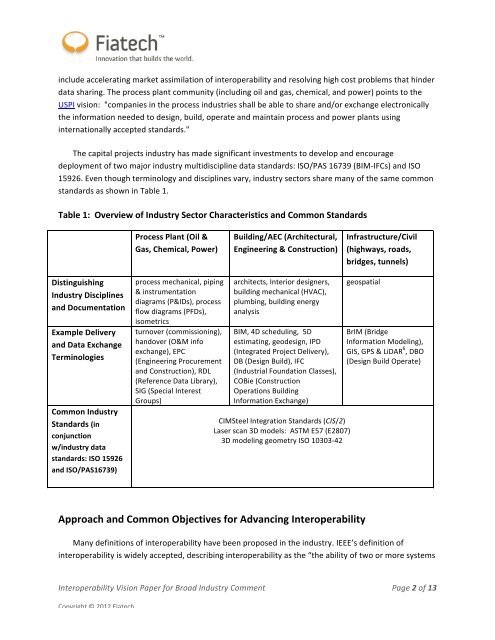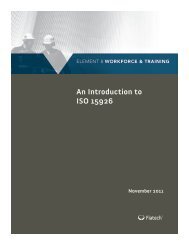Advancing Interoperability for the Capital Projects ... - iRINGToday
Advancing Interoperability for the Capital Projects ... - iRINGToday
Advancing Interoperability for the Capital Projects ... - iRINGToday
Create successful ePaper yourself
Turn your PDF publications into a flip-book with our unique Google optimized e-Paper software.
include accelerating market assimilation of interoperability and resolving high cost problems that hinder <br />
data sharing. The process plant community (including oil and gas, chemical, and power) points to <strong>the</strong> <br />
USPI vision: "companies in <strong>the</strong> process industries shall be able to share and/or exchange electronically <br />
<strong>the</strong> in<strong>for</strong>mation needed to design, build, operate and maintain process and power plants using <br />
internationally accepted standards." <br />
The capital projects industry has made significant investments to develop and encourage <br />
deployment of two major industry multidiscipline data standards: ISO/PAS 16739 (BIM-‐IFCs) and ISO <br />
15926. Even though terminology and disciplines vary, industry sectors share many of <strong>the</strong> same common <br />
standards as shown in Table 1. <br />
Table 1: Overview of Industry Sector Characteristics and Common Standards <br />
Process Plant (Oil & <br />
Gas, Chemical, Power) <br />
Building/AEC (Architectural, <br />
Engineering & Construction) <br />
Infrastructure/Civil <br />
(highways, roads, <br />
bridges, tunnels) <br />
Distinguishing <br />
Industry Disciplines <br />
and Documentation <br />
Example Delivery <br />
and Data Exchange <br />
Terminologies <br />
Common Industry <br />
Standards (in <br />
conjunction <br />
w/industry data <br />
standards: ISO 15926 <br />
and ISO/PAS16739) <br />
process mechanical, piping <br />
& instrumentation <br />
diagrams (P&IDs), process <br />
flow diagrams (PFDs), <br />
isometrics <br />
turnover (commissioning), <br />
handover (O&M info <br />
exchange), EPC <br />
(Engineering Procurement <br />
and Construction), RDL <br />
(Reference Data Library), <br />
SIG (Special Interest <br />
Groups) <br />
architects, Interior designers, <br />
building mechanical (HVAC), <br />
plumbing, building energy <br />
analysis <br />
BIM, 4D scheduling, 5D <br />
estimating, geodesign, IPD <br />
(Integrated Project Delivery), <br />
DB (Design Build), IFC <br />
(Industrial Foundation Classes), <br />
COBie (Construction <br />
Operations Building <br />
In<strong>for</strong>mation Exchange) <br />
CIMSteel Integration Standards (CIS/2) <br />
Laser scan 3D models: ASTM E57 (E2807) <br />
3D modeling geometry ISO 10303-‐42 <br />
geospatial <br />
BrIM (Bridge <br />
In<strong>for</strong>mation Modeling), <br />
GIS, GPS & LiDAR 6 , DBO <br />
(Design Build Operate) <br />
Approach and Common Objectives <strong>for</strong> <strong>Advancing</strong> <strong>Interoperability</strong><br />
Many definitions of interoperability have been proposed in <strong>the</strong> industry. IEEE’s definition of <br />
interoperability is widely accepted, describing interoperability as <strong>the</strong> “<strong>the</strong> ability of two or more systems <br />
<strong>Interoperability</strong> Vision Paper <strong>for</strong> Broad Industry Comment <br />
Page 2 of 13 <br />
Copyright © 2012 Fiatech.



